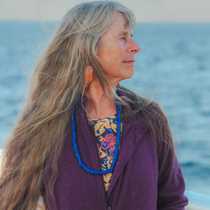Fort Clatsop – Demonstration of fire arms, circa 1805 – 1806
Sunrise found the Sea Lion moving west down the Columbia River, heading for Astoria, and the oldest sea port on the west coast of the United States. Astoria is also located near Fort Clatsop, the winter campsite of Lewis and Clark. From December 7, 1805 until March 28, 1806 the Corps of Discovery spent a very rainy winter and spring near the mouth of the Columbia River, and just a few miles from the Pacific Ocean.
During breakfast the Sea Lion pulled into the Coast Guard dock and tied up for the day. It was a short walk to our first stop at the Columbia River Maritime Museum. Founded in 1962, this museum is one of the finest maritime museums in the nation. Six galleries, the Great Hall, and the Lightship Columbia interpret the Pacific Northwest’s rich maritime history.
After our tour we had an opportunity to board busses and make the short journey out to Fort Clatsop located on the Lewis and Clark River just west of Young’s Bay. It is a reproduction of the fort constructed by the Corps of Discovery nearly two hundred years ago. Our national park system runs this facility, and after a brief introduction we were able to walk down to the reconstructed fort and visit the very compact quarters that the Corps used for the four months they spent on the Pacific Coast.
As we were all gathering inside Fort Clatsop, one of the park rangers appeared in apparel, circa 1805-1806….and over his shoulder he was carrying a rifle. In just a few moments we would all get a full explanation of just what it took to care for, load and fire a typical long rifle used during the era of Lewis and Clark. Before departure from the east coast Meriwether Lewis had obtained what he considered the rifle of choice for this long and difficult journey. The Corps of Discovery would carry smooth pore flintlock 45 caliber long rifles. As we watched, the National Parks ranger checked the barrel of his riffle, poured powder down that barrel, loaded it (with a large caliber wad of paper, for safety’s sake), and prepared to fire. We were told by the safety ranger present, that this type of rifle does not always fire…though, on the count of three with two great clouds of smoke and an extremely loud noise, a successful shot was fired, bringing back a moment in history.
Sunrise found the Sea Lion moving west down the Columbia River, heading for Astoria, and the oldest sea port on the west coast of the United States. Astoria is also located near Fort Clatsop, the winter campsite of Lewis and Clark. From December 7, 1805 until March 28, 1806 the Corps of Discovery spent a very rainy winter and spring near the mouth of the Columbia River, and just a few miles from the Pacific Ocean.
During breakfast the Sea Lion pulled into the Coast Guard dock and tied up for the day. It was a short walk to our first stop at the Columbia River Maritime Museum. Founded in 1962, this museum is one of the finest maritime museums in the nation. Six galleries, the Great Hall, and the Lightship Columbia interpret the Pacific Northwest’s rich maritime history.
After our tour we had an opportunity to board busses and make the short journey out to Fort Clatsop located on the Lewis and Clark River just west of Young’s Bay. It is a reproduction of the fort constructed by the Corps of Discovery nearly two hundred years ago. Our national park system runs this facility, and after a brief introduction we were able to walk down to the reconstructed fort and visit the very compact quarters that the Corps used for the four months they spent on the Pacific Coast.
As we were all gathering inside Fort Clatsop, one of the park rangers appeared in apparel, circa 1805-1806….and over his shoulder he was carrying a rifle. In just a few moments we would all get a full explanation of just what it took to care for, load and fire a typical long rifle used during the era of Lewis and Clark. Before departure from the east coast Meriwether Lewis had obtained what he considered the rifle of choice for this long and difficult journey. The Corps of Discovery would carry smooth pore flintlock 45 caliber long rifles. As we watched, the National Parks ranger checked the barrel of his riffle, poured powder down that barrel, loaded it (with a large caliber wad of paper, for safety’s sake), and prepared to fire. We were told by the safety ranger present, that this type of rifle does not always fire…though, on the count of three with two great clouds of smoke and an extremely loud noise, a successful shot was fired, bringing back a moment in history.




